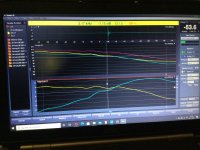A couple of comments ...
The quick sim I did indicates the 12NDH-4 would be one of the best choices you can get for the PM90/60.
If you use the XT1464 horn in the standard configuration only BMS driver will fit. (also check that the 4594 will still fit with the 12NDH-4).
B&C DCX464 /HF950 will fit I think, but check. Also the 464 with the PR614 may fit - but check I have not tried it.
I think the Ciare PR614 is possibly a better horn than the XT1464 ... BUT ... the XT1464 is bigger and goes lower which is an advantage in the PM60.
The difference between the PMA60 and the PM60 is the mids (100 - 700Hz} have a 5-6 dB output advantage.
Peter just to confirm we are talking about the -4 not the -3 correct? The -4 has a slightly higher motor force, however the -3 has greater sensitivity and lower Mms and the -3 has a ruler flat response of 100-101db from 100-1k
Thoughts between the two? I have on hand a pair of -4s but need to make a decision quickly if I’m going to go to the -3
Positive is that the depth of the Ciare PR614 is only about 186mm, which is about 22mm shorter than the XT.
The Ciare horn is appx 100mm shorter than the XT (and 50mm narrower) will this have any negative impact on the proximity center to center of the mid to HF cohesion at ~650hz?
Where is everyone crossing the BMS (not B&C) to the NDLs?
Thanks again.
Sent from my iPhone
Last edited:

